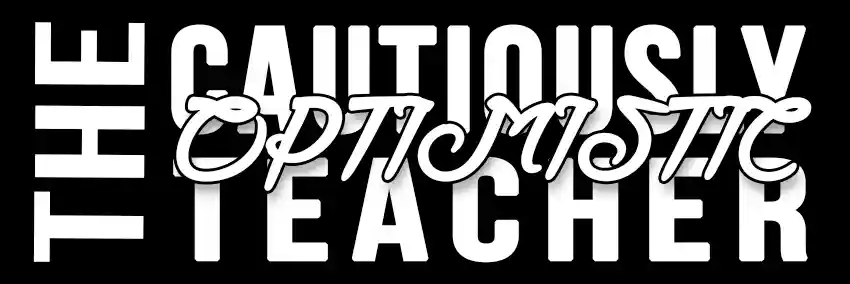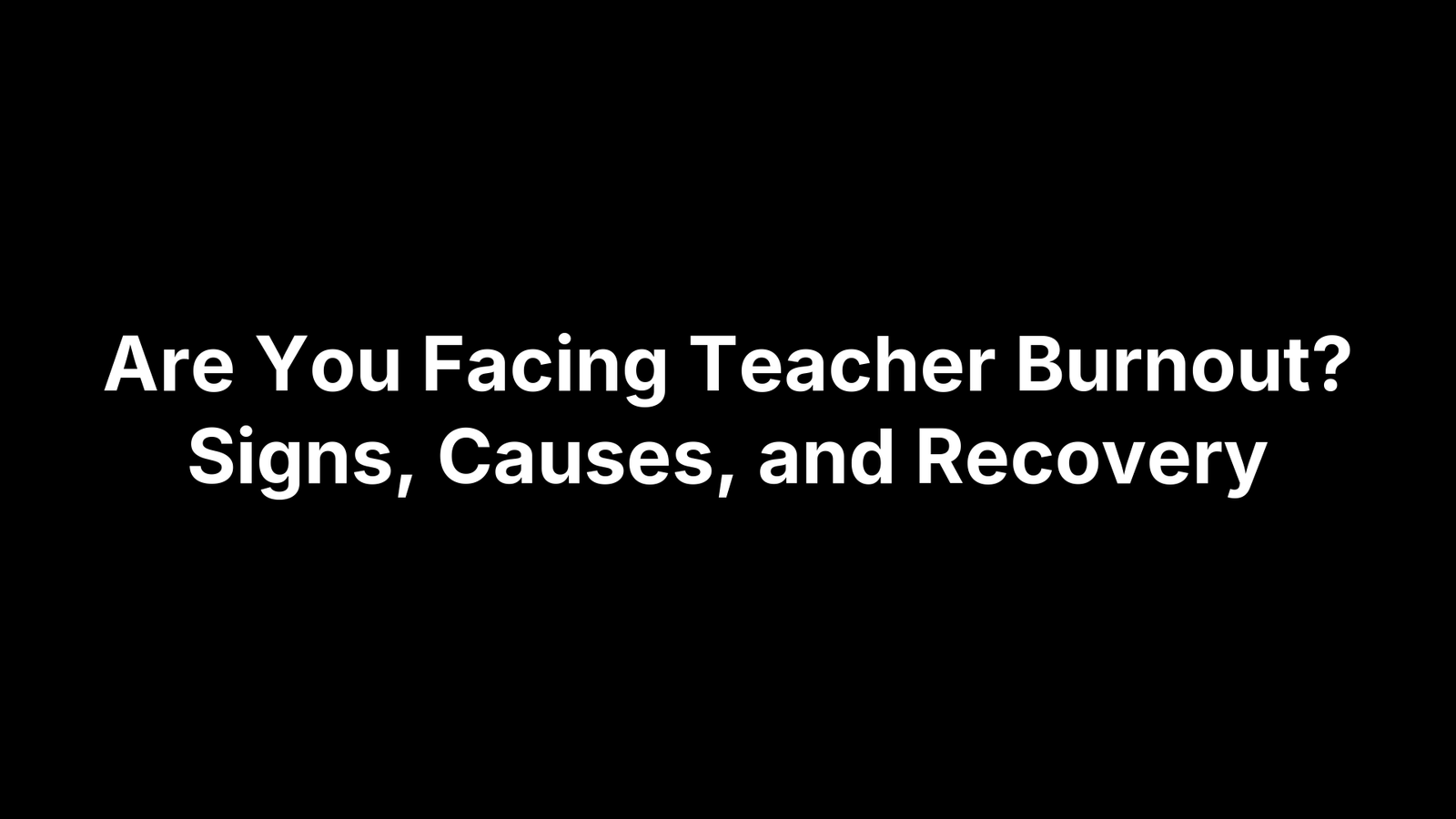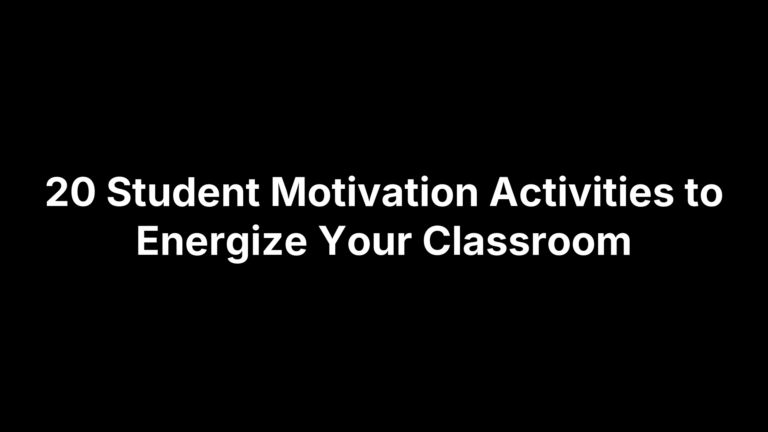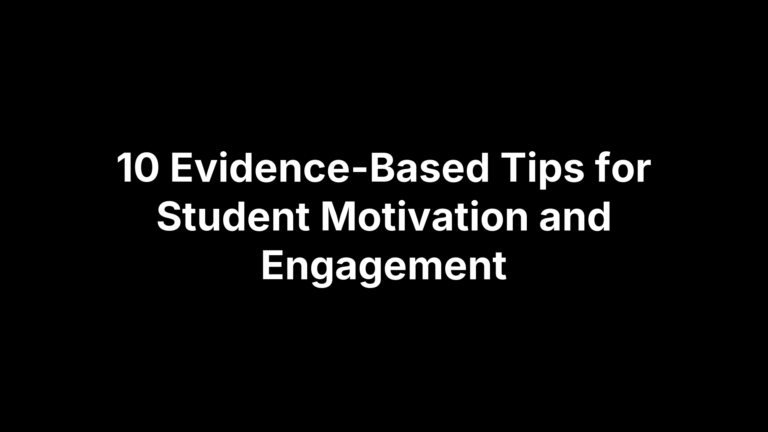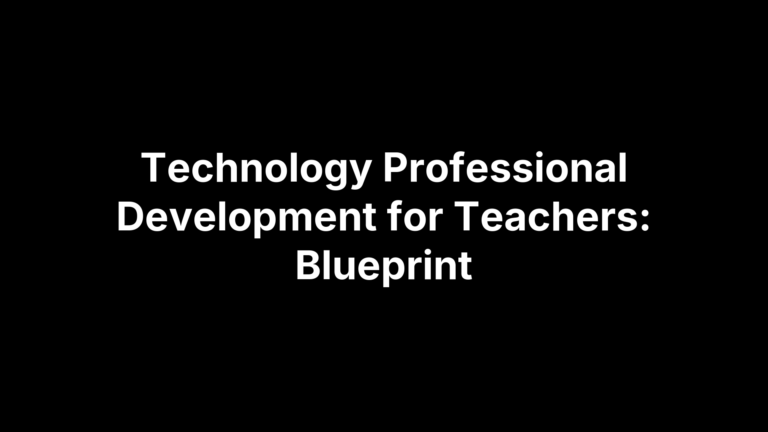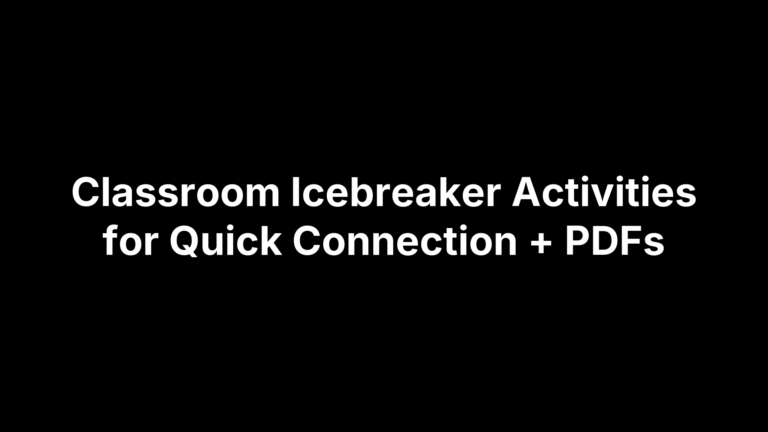Are You Facing Teacher Burnout? Signs, Causes, and Recovery
If teaching leaves you drained most days, quicker to frustration, and wondering where your energy went—even though you still care deeply about your students—you may be facing teacher burnout. In simple terms, teacher burnout is what happens when prolonged stress and competing demands deplete your emotional, mental, and physical reserves to the point that a job you once loved starts to feel unmanageable. It’s not a personal failure or a sign you’re “not tough enough.” It’s a predictable human response to chronic overload—and it’s increasingly common.
This practical guide explains what teacher burnout is (and isn’t), how widespread it is, the early warning signs to catch, and the root causes that fuel it. You’ll find research-backed prevention tips you can start this week, classroom strategies to ease behavior-related strain, and smart ways to use technology without adding to your workload. We’ll also cover why self-care matters but can’t fix systemic problems alone, how burnout affects students and school communities, and how to advocate for better conditions. Finally, you’ll get a quick self-check, a four-step recovery plan if you’re already burned out, guidance on when a role or school change might be right, and where to get help right now. Let’s get you the clarity—and relief—you need.
What teacher burnout is (and isn’t)
Teacher burnout is a work-induced state where you’ve “exhausted the personal and professional resources necessary to do the job,” as the National Education Association defines it. It builds over time—sustained stress and constantly shifting demands wear down your energy, focus, and hope until teaching feels unmanageable. Some educators describe a related experience as demoralization: not just exhaustion, but the pain of being unable to do the work well because of system-level barriers. Both are real—and neither is a personal failing.
- What it is: A gradual depletion of emotional, mental, and physical reserves from chronic workload, behavior challenges, inadequate support, and conflicting expectations. It often shows up as exhaustion, cynicism, and reduced effectiveness.
- What it isn’t: A bad day, end-of-term fatigue, or “not being tough enough.” It’s also not something you can fix with self-care alone; without addressing root causes at school and district levels, relief won’t last.
How common is teacher burnout today: key statistics you should know
Teacher burnout isn’t rare—it’s the norm many educators are navigating. Surveys since the pandemic show sustained stress, rising behavior challenges, and persistent staffing gaps that compound daily pressures. The figures below sketch the scope, from how many teachers feel burned out to how often they consider leaving and the systemic stressors driving the trend.
- 44% of K–12 teachers report feeling burned out “often” or “always” (Gallup).
- 78% have thought about quitting since the pandemic, citing workload, limited support, pay, and student behavior (University of Missouri study reported by NEA).
- Public schools employ 500,000+ fewer educators than before the pandemic (BLS/NEA).
- Student behavior is the top stressor for 44% of teachers (RAND, 2024).
- Reviews find burnout prevalence ranges from 25% to 74%, with stress reported by 8.3%–87.1% of teachers across studies (systematic review).
- Teachers are more than twice as likely to be stressed as other working adults (RAND/Gallup analyses).
Early warning signs of burnout to watch for
Burnout rarely arrives overnight—it creeps in. The earliest clues look like small slips in energy, focus, or patience that stick around for weeks. Don’t wait for a crisis to take stock. If several of the signs below show up consistently, treat them as useful data and a prompt to reset your workload, supports, and boundaries.
- Emotional shifts: Irritability, mood swings, growing cynicism or detachment, feelings of hopelessness, rising anxiety or low mood.
- Cognitive strain: Forgetfulness, trouble concentrating, indecision, feeling mentally “foggy” during planning or instruction.
- Physical red flags: Chronic fatigue, insomnia, headaches, stomach/GI issues, heart palpitations, dizziness, frequent illness, appetite or weight changes, irregular hair loss.
- Work performance dips: Reduced motivation, procrastination, needing more time for routine tasks, slipping deadlines, declining job satisfaction.
- Connection and recovery: Pulling back from colleagues or students, loss of enjoyment, inability to relax or enjoy downtime even when “off.”
Try a simple two‑week check-in: note sleep, energy, mood, and workload each day. If patterns persist, loop in a trusted leader, peer mentor, or health professional. You’re not the problem—the conditions are. Next, let’s look at the root causes that drive these patterns.
Root causes of burnout in teaching
Burnout in teaching rarely stems from a single “bad week.” It’s the cumulative weight of workplace factors that research has repeatedly flagged since the pandemic: heavier workloads amid staff shortages, limited administrative support, escalating student behavior challenges, stagnant pay, and initiatives that multiply tasks without removing old ones. Add micromanagement, shifting expectations, and a politicized climate, and even skilled, committed educators can feel they’re pushing a boulder uphill.
- Escalating student behavior: The top job-related stressor for 44% of teachers (RAND, 2024).
- Chronic overload and vacancies: Public schools have 500,000+ fewer educators than pre‑pandemic, forcing remaining staff to take on extra duties (BLS/NEA).
- Limited support and shifting directives: Lack of administrative backing and constantly changing expectations push many to consider quitting (University of Missouri; NEA reporting).
- Inadequate compensation: A leading reason educators plan to leave (McKinsey), even as pay alone can’t fix conditions.
- Tech that adds, not subtracts: When new platforms don’t replace old requirements, burnout rises (Auburn University).
- Policy and culture pressures: High‑stakes testing, public attacks on schools, and politicized debates erode professional autonomy (NEA reporting).
- Class size, planning time, and enforcement burdens: Larger rosters, too little prep, and daily cellphone enforcement compound strain.
These are structural drivers—not individual weaknesses—setting the stage for burnout.
Systemic versus individual factors: why self-care alone isn’t enough
You can meditate, meal‑prep, and guard weekends—and still feel crushed by a schedule that never lets up. As one educator put it in NEA reporting, “you can’t just yoga, breathe, and self-care yourself out of burnout.” Teacher burnout is largely produced by systems: chronic vacancies that bloat workloads, behavior challenges without adequate supports, micromanagement, and tech that piles on tasks instead of replacing them. Personal habits help you cope; they don’t fix conditions that keep creating stress.
What moves the needle is aligning individual care with structural change. Surveys show student behavior is the top daily stressor (RAND), while 78% of teachers have considered quitting over workload, limited admin support, pay, and behavior (University of Missouri). When new platforms are added without removing old requirements, burnout rises (Auburn University). That’s a design problem, not a resilience problem.
- Staffing and time: Hire and protect planning time; stop duty creep.
- Behavior supports: Clear, enforced policies and access to specialists.
- Autonomy and trust: Fewer directives; more teacher voice in curriculum.
- Tech hygiene: Only adopt tools that replace existing tasks.
- Fair compensation: Pay that matches responsibility and retains talent.
Pair self-care with these levers, and relief becomes sustainable.
How burnout affects students and school communities
Teacher burnout doesn’t stay in the staff room—it shows up in classrooms and hallways. When educators are depleted, instruction suffers and students learn less, as school psychology researcher Wendy Reinke notes. Staffing shortages (public schools employ 500,000+ fewer educators than pre‑pandemic) force larger classes or uncertified hires, making effective teaching harder. Disruptive behavior can snowball across grades and years, and high turnover erodes the stable relationships students rely on. The result is a school culture that feels less safe, less connected, and less focused on learning.
- Less effective instruction: Lower energy and focus reduce feedback, differentiation, and momentum.
- Weaker relationships: Turnover breaks continuity that anchors student growth and trust.
- Behavior spillover: Disorderly classrooms seed more disruptions in subsequent grades.
- Community strain: Families feel confidence dip; remaining staff shoulder unsustainable loads.
A quick self-check to gauge where you are
Use this quick pulse check to spot early teacher burnout patterns. Think about the past two weeks, not your toughest day. For each item, choose Often, Sometimes, or Rarely, and keep it honest—this is a guide, not a diagnosis.
Often = 2, Sometimes = 1, Rarely = 0
- Energy crash after school most days.
- Sleep trouble: falling or staying asleep 3+ nights a week.
- Morning dread before the day starts.
- Patience slipping or growing cynicism with students.
- Physical strain: recurring headaches, stomach issues, or palpitations.
- No real off-time: downtime isn’t restful; mind loops back to school.
Add your points: 0–4 = monitor; 5–8 = adjust supports now; 9+ = prioritize recovery and reach out for help. Up next: practical prevention moves you can start this week.
Prevention strategies you can start this week
You can’t fix systemic issues in a week, but you can create margin and reduce friction. These simple moves lower cognitive load and help prevent teacher burnout. Pick two to start, commit for 14 days, and notice what actually changes.
- Name your top three: Decide the week’s three outcomes; defer or delete everything else.
- Timebox grading/planning: Two 25‑minute blocks; stop when time ends and schedule carryover.
- Subtract before you add: When a new task appears, ask what stops—propose one pause.
- Use “good enough” templates: Reuse comment banks and unit skeletons; draft with AI starters (worksheet maker, question generator), then edit.
- Batch communication: One parent email window and a 15‑minute student message block; mute alerts during class.
- Build two Plan B lessons: Low‑prep retrieval practice or a discussion protocol for rough days or subs.
- Reteach two key routines: Entry and device use; post steps and practice—10 minutes now saves hours later.
- Protect one no‑work block: Calendar a 60–90 minute block this week and treat it as non‑negotiable.
Classroom strategies to reduce stress and behavior-related strain
When student behavior becomes your top daily stressor, small, consistent moves can restore calm and protect your bandwidth. You can’t control every variable, but you can design smoother starts, clearer routines, and quicker resets so fewer moments turn into power struggles. These classroom tactics reduce friction, limit device disruptions, and keep instruction moving—key buffers against teacher burnout.
- Win the first five minutes: Post a Do Now, greet at the door, start a timer, take attendance while students work.
- Teach, practice, reteach routines: Model and rehearse entry, transitions, voices, and materials weekly; praise what you want repeated.
- Pre-correct before problems: Give brief, specific reminders (“In 30 seconds, phones in caddy, eyes on me”) to prevent missteps.
- Use proximity and active supervision: Walk predictable circuits; linger where off-task behavior starts and redirect quietly.
- Offer neutral choices: “You can work at your desk or table group—your pick—due by 10:20.”
- Standardize device use: Adopt a simple rule (e.g., “Off and Away”) with caddies or designated zones; enforce consistently with school-backed steps.
- De-escalate fast: Low voice, short script, private chat: “I want you to be successful—let’s step into the hall for a quick reset.”
- Protect instructional momentum: Lean on low‑prep structures (retrieval prompts, think‑pair‑share, discussion protocols) when energy dips.
Put two of these in play this week; then add a third once they stick. Next, let’s widen the lens to advocating for the conditions that make these routines sustainable.
Advocate for better working conditions at your school or district
You don’t have to shoulder this alone. With student behavior now the top stressor for 44% of teachers and more than 500,000 fewer educators than before the pandemic, leadership needs clear, doable fixes that protect instruction and retention. The wins other locals have achieved—like enforceable cellphone policies and more teacher autonomy—started with specific, data‑backed asks tied to student outcomes.
- Quantify the problem: Track two weeks of lost instructional minutes (behavior, coverage, tech glitches) and note impacts on learning.
- Build a coalition: Loop in grade-level teammates, counselors, SPED staff, and your union rep; align on 2–3 priority asks.
- Make subtractive, specific asks:
- Enforceable cellphone policy with clear steps.
- Protected planning time and a stop to duty creep.
- Class size caps or an additional aide in high‑need sections.
- Behavior supports (on-call specialist, reset room, Tier 2/3 time).
- Tool/initiative consolidation—add only if something else is removed (research shows “add-on” tech raises burnout).
- Bring models and pilots: Sample contract language, a 6–9 week pilot with metrics (referrals, time on task), and a review date.
- Use formal channels: Labor–management committees, school board testimony, and bargaining proposals; document agreements in writing.
- Close the loop: Share results and next steps with staff and families to build momentum for the next win.
Use technology to lighten the load, not add to it
The right tools should give you time back. Research has shown that when new platforms (think Canvas or Schoology) are layered on without removing old requirements, teacher burnout increases. Use a “subtract before you add” mindset so tech replaces tasks, eliminates double entry, and automates routine work—without creating new busywork.
- One-in, one-out: If you adopt a new workflow, retire the old spreadsheet or form.
- Template everything: Comment banks, rubrics, email scripts, and lesson shells save hours.
- Automate the first draft: Use tools to draft objectives, question stems, and report comments—then edit.
- Integrate, don’t duplicate: Sync gradebook, rosters, and attendance; avoid entering data twice.
- Batch and schedule comms: Post weekly LMS announcements; use scheduled send for parent emails.
- Timebox and mute: Work in short sprints and silence notifications during instruction to protect focus.
Time-saving tools for planning, grading, and differentiation
The fastest way to ease teacher burnout is to reclaim hours from planning and feedback without sacrificing quality. Lean on templates, auto-grading, and AI drafts that you refine. The goal isn’t perfection—it’s consistent, good-enough systems that lower your cognitive load and keep instruction moving.
- Unit and lesson templates: Reuse weekly shells (Do Now, mini-lesson, practice, exit ticket) so you plan by slotting content, not reinventing structure.
- Question Generator: Create standards-aligned checks for understanding in seconds, then edit for rigor; build banks you can remix each term.
- Worksheet Maker: Turn keywords or objectives into printable/Google-ready practice with auto-generated answer keys to speed checks.
- Auto-grading quizzes: Use your LMS/forms to grade objective items, release instant feedback, and flag reteach groups—no double entry.
- Rubrics + comment banks: Attach concise criteria and reusable comments to speed grading while keeping feedback specific.
- Report Card Commentor: Draft individualized comments from rubric data and observations, then personalize quickly.
- Differentiated Instruction Helper: Generate tiered tasks, reading levels, language supports, and enrichment so diverse learners get what they need—without tripling prep.
- Batch-and-schedule comms: Write one weekly agenda/announcement and schedule it; point families and students there to reduce one-off emails.
Adopt two tools, measure minutes saved for two weeks, and keep only what clearly gives time back.
A four-step recovery plan if you’re already burned out
If you’re past “tired” and into “I can’t keep doing this,” you need a reset plan, not more grit. Use this short, structured recovery to stabilize, get help, and rebuild a sustainable rhythm. Teacher burnout is common—and reversible when conditions change.
Stabilize this week (triage). Take a sick/mental health day if needed. Pause nonessential tasks and “duty creep.” Run Plan B, low‑prep lessons, timebox grading to two short blocks, mute notifications, and ask for coverage where required. Aim for “good enough,” not perfect.
Build your support net (72 hours). Brief your administrator on what you’re pausing and why; request behavior support and protected planning time. Loop in a trusted colleague and union rep. Use your EAP/health benefits to schedule with a licensed counselor or physician. Burnout is a health issue, not a weakness.
Redesign the next six weeks. Pick three weekly outcomes; subtract one committee or initiative. Consolidate platforms—new tech should replace, not add (add‑on tools are linked to higher burnout). Batch communication, and reteach two key routines (entry, devices) to cut behavior friction.
Review and decide (week 4–6). Track sleep, energy, and minutes of instruction regained. If your load and wellbeing aren’t clearly improving, explore formal options with leadership and your union: reduced sections, reassignment, transfer, or leave. Your next move should protect your health and your craft.
When it might be time to change roles, schools, or careers
If you’ve implemented recovery steps, tightened routines, and advocated for support—but your health, energy, and instruction haven’t improved—changing context may be the most caring move for you and your students. Look at patterns over 4–6 weeks, not one rough day. Leaving isn’t “giving up”; it’s choosing a setting where you can do your best work—or starting a new chapter.
- Health isn’t rebounding after reduced load and added supports.
- Admin support is absent or unreliable; duties keep creeping.
- Behavior strain stays high without added staffing or structures.
- Values don’t fit: heavy micromanagement, little autonomy or trust.
- Daily dread outweighs joy most weeks; recovery time never sticks.
- Home life suffers (sleep, relationships, finances) with no relief in sight.
- A sustained pull to new work (e.g., curriculum, instructional design, educational consulting) keeps growing.
Before a full exit, explore an internal transfer, different grade/subject, interventionist or coaching roles, reduced load, or a short leave. Clarify your non‑negotiables, set a decision date, and treat the search like a project: align your portfolio/resume, line up references, and confirm union/HR timelines.
Where to get help right now
You don’t have to white‑knuckle this. Burnout is a health issue, not a character flaw, and real help is available today. Start by stabilizing your week, then pull in the right supports so you’re not carrying this alone. Use the options below in whatever order you can act on fastest.
- Immediate safety: If you’re at risk, contact local emergency services or go to the nearest ER.
- Health care fast-track: Book with your primary care clinician or a licensed counselor; ask HR about your district’s EAP for 24/7 phone counseling.
- Workplace adjustments: Email your administrator to pause nonessential duties, request behavior support, and protect planning time.
- Union support: Contact your union rep to document issues and pursue solutions, transfers, or leave options.
- Peer check‑in: Ask a trusted colleague to meet weekly for a 10‑minute reset.
- UK readers: Education Support offers a free, confidential 24/7 helpline for educators at 08000 562 561.
Before you go
You’re not broken—the job has been. The good news is that small, consistent moves can restore margin, and structural wins can stick. Choose two prevention habits for this week, reteach one routine that protects your energy, and make one clear, subtractive ask at school. If you’re already past the line, follow the four-step recovery plan and loop in support—health care, admin, and your union—so you’re not carrying this alone.
When you’re ready for more practical help, we’ve built time-savers for planning, questions, differentiation, and reports to give you hours back. Get weekly strategies and access classroom-ready tools at The Cautiously Optimistic Teacher—and keep the focus where it belongs: on teaching well without burning out. You’ve got this.
